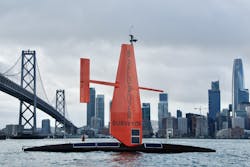At Siemens Digital Industries Software recent media and analyst event in Detroit, the company highlighted numerous examples of customers putting digital twin technology to use. And though it’s common to think of the digital twin as being a tool geared toward large companies with significant numbers of engineers on staff, Siemens focused on how smaller companies are using the technology too. These applications helped showcase Siemens’ increasing focus on small to medium sized businesses through its shift toward delivering its technologies as a service.
Saildrone is using Siemens Xcelerator cloud-based portfolio as a service, including NX software for 3D product engineering and Teamcenter X for product lifecycle management (PLM) to improve design collaboration across the organization without the need for traditional product design IT infrastructure to support it.
“We chose Teamcenter X because it's very important to have a single source of truth for engineering, especially as a small startup,” said Andrew Schultz, chief technology officer at Saildrone. “Manufacturing uses it for purchasing and building the components in our drones, and our finance and G&A teams use it to track inventory. Our primary focus is engineering—building new products and making our drones and our mission services better—not having to manage and update an on-premises server.”
Subsea agriculture
Another startup user of Siemens’ cloud-based Xcelerator as a service offering is Nemo’s Garden, which is working on sustainable underwater cultivation of crops.
According to Siemens, Nemo’s Garden’s key innovation is a sub-aqua biosphere—an underwater greenhouse designed to use the ocean’s temperature stability, evaporative water generation, CO2 absorption, abundance of oxygen, and inherent protection from pests to create an environment for the underwater cultivation of herbs, fruits, and vegetables. Nemo’s Garden has already proven the viability of its concept, so they’re looking to use the Xcelerator portfolio to turn their prototype into a product that can be deployed globally.
A comprehensive digital twin of the Nemo’s Garden biosphere has been built to encompass its design evolution using Siemens NX software. Simulation of the growing conditions are done using Siemens Simcenter Star-CCM+ software. With these digital twin technologies, adaptations to the biospheres can be tested in the virtual world, enabling the team at Nemo’s Garden to refine their designs at an accelerated rate.
“Nemo’s Garden is a one-of-a-kind system, and we need to adapt it to each environment where it is to be installed,” said Luca Gamberini, co-founder of Nemo’s Garden. “If you can model that environment virtually before you start, you can foresee the challenges and address them in the best way. [With Siemens digital twin technology] we have seen benefits in understanding the flow of water around the shapes of our biospheres, have a greater understanding of the points of stress on the structure around the biospheres, and understand how the different interactions of solar radiation, temperature, and [other] physical factors act on the plants.”
Siemens’ cloud-based MindSphere service was used by Nemo’s Garden to analyze video of the growing cycles along with reference data from traditional farming operations of the same target crops at various growth stages and health conditions. From this combination of data, Siemens was able to train a machine learning algorithm to monitor plant growth and the environmental conditions within the domes.
When this algorithm is deployed onto Siemens’ Industrial Edge computing devices in each biosphere, the plants can be monitored from anywhere via a cloud-based dashboard. According to Siemens, these Industrial Edge devices will be connected to actuators to automatically adjust air circulation, humidity, irrigation, and nutritional dosing throughout the growing season. Nemo’s Garden plans to use this as the foundation of a global subsea agricultural service optimized for each of the world’s oceans.
Leaders relevant to this article:


